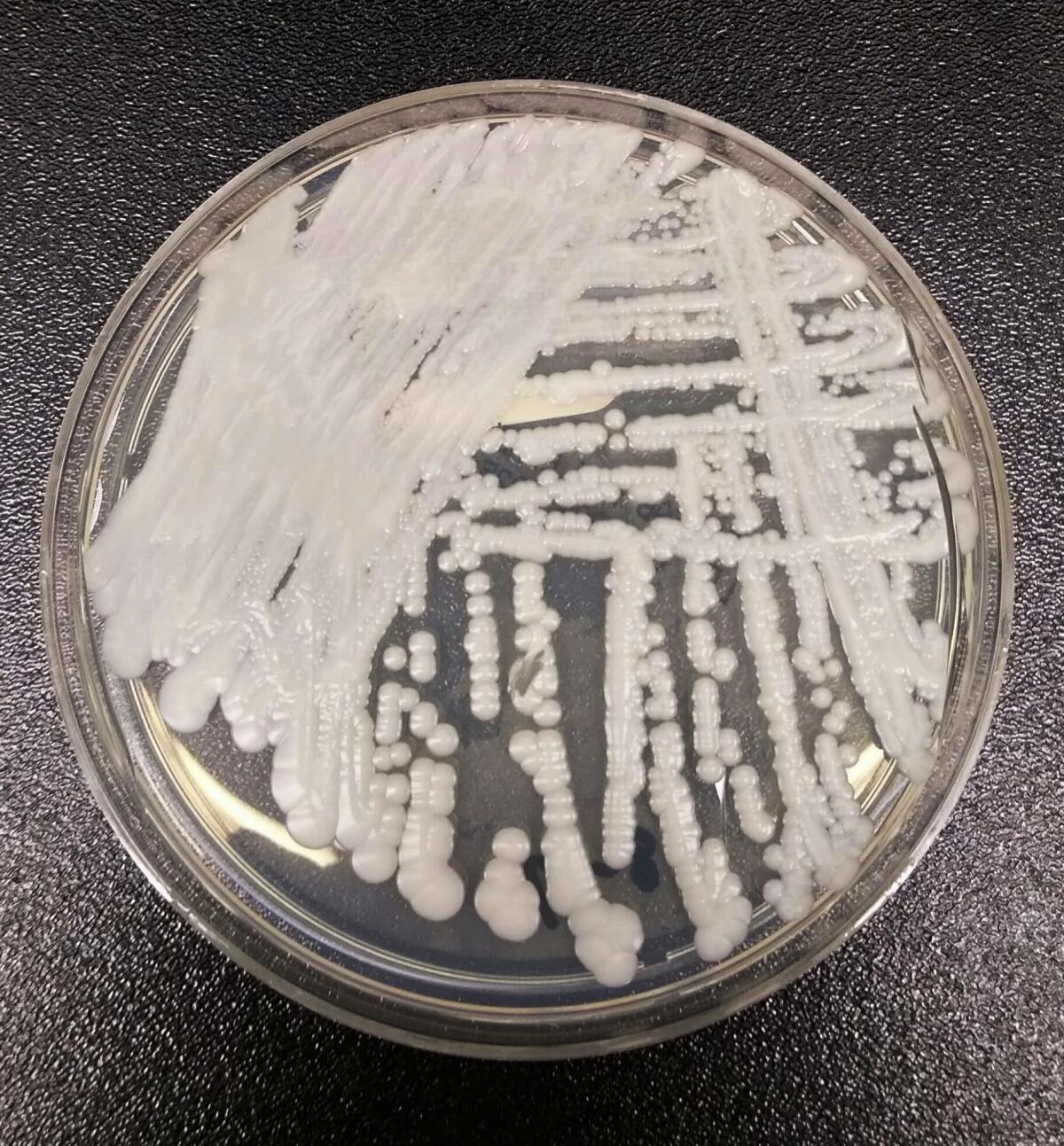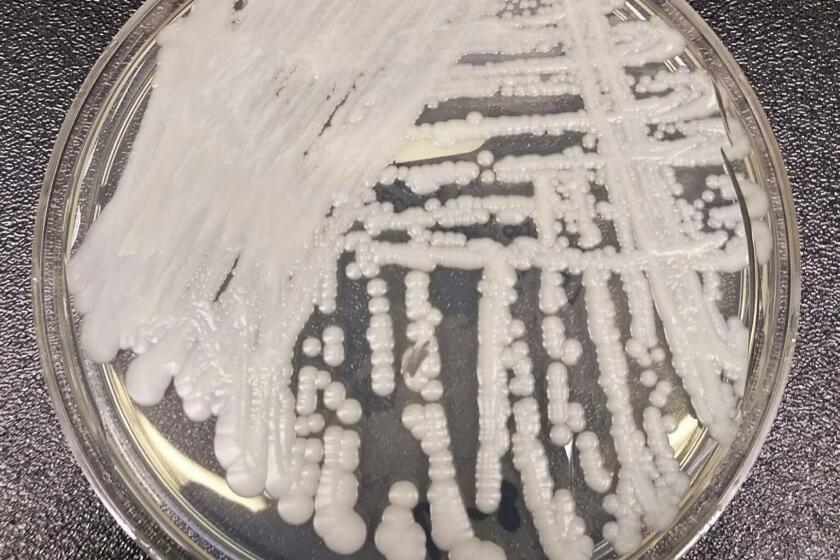Opinion: This rapidly spreading deadly fungus is a warning about climate change

- Share via
Last month, the United Nations’ Intergovernmental Panel on Climate Change charted global temperatures to be 1.1 degrees Celsius above preindustrial levels and on a destructive trajectory to surpass 1.5 degrees Celsius of warming by the early 2030s. This intersects surprisingly with another piece of news: the Centers for Disease Control and Prevention sounding the alarm on a sometimes deadly pathogenic yeast that’s spreading rapidly in healthcare facilities.
Researchers increasingly believe that the yeast, Candida auris, is the first pathogenic fungus to arise from global warming. Its growing microbial footprint will test how prepared the world is for the disease pressures we face from climate change.
In 2022, there were nearly 2,400 C. auris infections in 28 states, with Nevada and California reporting the highest numbers. Clinical cases have increased every year since 2016. The 2022 count is almost 40 times what amounted over a three-year span starting in 2013, the year of the first known case in the United States. (The fungus was first discovered in any human in 2009, when doctors recovered it from a Japanese woman’s ear and named it accordingly — auris is Latin for ear).
Candida auris, a potentially deadly fungus that is resistant to drug therapy, is spreading rapidly across California and the U.S., the CDC said.
Fungi are everywhere and very much part of human life. Scientists believe that we have long been protected against invasive fungal diseases by our warm core temperature, which few fungal species could tolerate. But innate to any living organism is the ability to adapt. In the ecosystems of coastal wetlands where C. auris has been found in the soil, rising temperatures and salinity have hardened the fungus’ resolve, likely enabling it to survive even at the body temperature of mammals. It then somehow reached humans. One theory is that waterfowl served as the ecological bridge, picking up the fungus and dispersing it to human environments.
Candida is a type of yeast with about 200 different species, not all of which lead to devastation. A pathogen’s virulence is the product of its interaction with its host. This may explain why infections wrought by C. auris aren’t typically life-threatening to the average person. But medically vulnerable patients with impaired immune systems — including those with diabetes or renal disease, or who have had an organ transplant — are more susceptible to critical illness. Moreover, C. auris generally resists at least two major classes of antifungals, and potentially as many as four, pushing providers to treat it with drugs that are still unproven.
C. auris’ other danger lies in the ability of fungi to hole up in the human body, alongside the trillions of microorganisms that naturally inhabit us, without manifesting signs of an infection. Infectious disease physicians refer to this as colonization.
C. auris is more likely to reach and colonize hosts in healthcare settings — a result of patients’ frequent contact with hospitals and nursing homes, medical devices or catheters that bore beneath the skin, connections to ventilators, or repeated courses of antibiotics.
Once on a medical ward, C. auris clings tightly to whatever surface it finds — curtains, floors, bed rails, equipment monitors, IV poles. Evidence has shown that C. auris can persist on both moist and dry surfaces — even the ends of digital thermometers — for up to several weeks, transferring onto unsuspecting patients and fueling hospital outbreaks around the world.
Our warming world means billowing fires, breaking glaciers — and deadlier diseases.
The COVID-19 pandemic almost surely exacerbated outbreaks of this fungus. Underresourced public health systems had to extend the use of personal protective equipment such as gowns and gloves in light of shortages, likely propagating its spread. And overwhelmed infection prevention and control teams could focus only myopically on managing and containing COVID-19, at the expense of broader oversight.
But most important, C. auris’ ascent looks to be a harbinger of the health effects of climate change. Despite the planetary scale of the problem, it presents a moment to reinforce the crucial minutiae of basic public health measures: consistent case-by-case surveillance and monitoring to curb disease.
To prevent outbreaks, healthcare facilities routinely use swabs to screen patients for multidrug-resistant organisms such as the bacteria MRSA and VRE. A positive test alerts staff, who then take extra precautions to prevent the organisms’ spread from the patient who carries it. In that vein, C. auris screening should become standard with patients’ statuses communicated across institutions (four outbreaks in Los Angeles County started with hospitals receiving a patient they did not know was colonized).
As we gather this information about an actively circulating pathogen, the CDC must standardize requirements to report it. While cases of C. auris have been nationally notifiable since 2019, it is still not a reportable disease in every state. This means that the only data the CDC receives to drive its guidance is what state health departments voluntarily submit. With some choosing not to submit their case data, or worse, not collecting it in the first place, cases are likely underreported. Screening and surveillance work in tandem. Expanding and standardizing their processes should form the backbone of our approach to rising pathogens.
Climate change will invariably bring new fungal diseases. A threat to our collective well-being is best met with a collective effort. C. auris offers us a chance to strengthen that response.
Arjun V.K. Sharma is a writer and infectious disease resident physician. @ArjunVKSharmaMD
More to Read
A cure for the common opinion
Get thought-provoking perspectives with our weekly newsletter.
You may occasionally receive promotional content from the Los Angeles Times.












